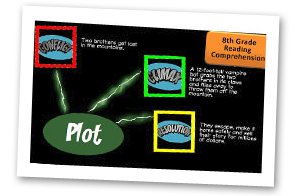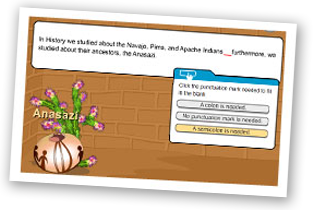8th Grade Reading Strategy and Curriculum Standards
An essential part of the 8th grade reading strategy is development of writing skill along with reading skill. Students use language arts worksheets created to help them write clear, coherent, and focused essays. These essays must contain formal introductions, supporting evidence, and conclusions. 8th grade reading strategy language arts lessons help students create an organizational structure that balances all aspects of a composition and uses effective transitions between sentences to unify important ideas. As part of the 8th grade reading strategy, students are expected to support all statements and claims with anecdotes, descriptions, facts and statistics, and specific examples. This year they learn to develop strategies for note taking, outlining, and summarizing in order to impose structure on their composition drafts.
Interested in a full 8th grade curriculum? Parents might also find the 8th grade curriculum overview helpful.
8th Grade Writing Applications
Other language arts lessons and language arts worksheets develop research report writing and reading skill. 8th grade reading strategy students are expected to pose relevant and tightly drawn questions about the topic and to convey clear and accurate perspectives on the subject. During this language arts activity students are asked to include evidence compiled through the formal research process using a card catalog, Reader’s Guide to Periodical Literature, a computer catalog, magazines, newspapers, and dictionaries. They are expected to document reference sources by means of footnotes and a bibliography.
The art of writing persuasive compositions is another important aspect of the 8th grade reading strategy reading skill program. While writing persuasive compositions they are expected to state a clear position or perspective in support of a proposition or proposal, and then to describe points in support of the proposition, employing well-articulated evidence. 8th grade reading strategy writing students should anticipate and address reader concerns and counterarguments when creating their persuasive compositions. When writing summaries of reading materials 8th grade reading strategy students should include the main ideas and most significant details. Using their own words, except for quotations, they should consider and reflect the underlying meanings of a work, rather than just superficial details.
For the 8th grade reading strategy, an important part of writing language arts lessons is a student’s ability to revise writing to improve organization and word choice after checking the logic of the ideas and the precision of their own vocabulary. Language arts worksheets may be used to help students organize their thoughts prior to writing.
Good grammar is of vital importance for 8th grade reading strategy students. This year they will use language arts worksheets to learn to identify and use infinitives and participles and to make clear references between pronouns and antecedents. They learn to identify all parts of speech and types and structure of sentences. And they have language arts lessons asking them to demonstrate the mechanics of writing, using quotation marks and commas at end of dependent clauses, and appropriate English usage. Sentence structure is important and 8th grade reading strategy students will learn to place modifiers properly and use the active voice. Punctuation language arts lessons, another vital language arts activity, focuses on identification of hyphens, dashes, brackets, and semicolons and the correct use of them. Students are expected to use correct capitalization when completing their language arts lessons. The 8th grade reading strategy also emphasizes the need for children to spell derivatives correctly by applying the spellings of bases and affixes.
Language arts lessons for 8th grade reading strategy students include development of reading skill by writing narrative, expository, persuasive, and descriptive texts of at least 500 to 700 words in each genre. 8th grade reading strategy language arts activity requires that 8th grade students revise writing to improve organization and word choice after checking the logic of the ideas and the precision of the vocabulary. Students need to demonstrate a command of standard American English and must possess research, organizational, and drafting strategies appropriate for the 8th grade reading skill level.
Fictional and autobiographical narratives are an important 8th grade reading strategy language arts activity in which they will establish and develop standard plot lines having a beginning, conflict, rising action, climax, and denouement, and an appropriate point of view. While writing they will be instructed to develop complex major and minor characters and a definite setting. Other strategies they will be encouraged to use will include dialogue, suspense, naming of specific narrative action, and including movement, gestures, and expressions. In addition 8th grade reading strategy students write responses to literature that develop interpretations exhibiting careful reading, understanding, and insight. Language arts worksheets may help them organize interpretations around several clear ideas, premises, or images from the literary work. Also these 8th grade reading skill students are expected to justify their interpretations through sustained use of examples and textual evidence.

In eighth grade language arts, Maxine teaches about the components of plot in an interactive guided instruction.
In this lesson, students create a storyline and answer questions about plot as their story unfolds.

8th Grade Speaking & Reading Strategy
The 8th grade reading strategy includes development of listening and speaking skills. Students are expected to deliver focused, coherent presentations that convey ideas clearly and relate to the background and interests of the audience. 8th grade reading strategy students evaluate the content of oral communication of others. This vital language arts activity adds to a student’s reading skill and comprehension as students learn to listen critically and respond appropriately to oral communication. Language arts lessons and language arts worksheets help them organize information to achieve particular purposes and to appeal to the background and interests of the audience. Students enrolled in 8th grade reading strategy language arts lessons are expected to arrange supporting details, reasons, descriptions, and examples effectively and persuasively in relation to the audience, and to use speaking techniques, including voice modulation, inflection, tempo, enunciation, and eye contact, for effective presentations.
8th grade reading strategy students deliver well-organized formal presentations employing traditional rhetorical strategies including narration, exposition, persuasion, and description. Student speaking should demonstrate an ability to use standard American English. Elements of the speaking component of their language arts lessons will be to deliver narrative presentations, oral summaries of articles and books, research presentations, and persuasive presentations.
Students deliver well-organized narrative presentations demonstrating 8th grade reading skill in establishing a context, point of view, and a standard plot line having a beginning, conflict, rising action, climax, and denouement. Their narrative presentations should describe complex major and minor characters and a definite setting. In delivering these presentations 8th grade reading strategy students are expected to use a range of appropriate strategies, including dialogue, suspense, and naming of specific narrative actions such as movement, gestures, and expressions.
These language arts lessons also require that 8th grade reading strategy students deliver oral summaries of articles and books that include the main ideas of events or articles and the most significant details. Using their own words, except for material quoted from sources, they demonstrate their comprehension and understanding of sources rather than conveying only superficial details.
Research presentations are another component for the 8th grade reading strategy. Students are instructed to pose relevant and concise questions about topics and to convey clear and accurate perspectives on the subject. They learn to include evidence generated through formal research processes such as use of a card catalog, Reader’s Guide to Periodical Literature, computer databases, magazines, newspapers, or dictionaries, and to cite reference sources appropriately. Language arts worksheets may be helpful in preparation for the delivery of these research presentations. Students enrolled in 8th grade language arts lessons deliver persuasive presentations, stating a clear position or perspective in support of an argument or proposal. This language arts activity requires that they describe the points in support of the argument and employ well-articulated evidence.
Another vital part of the 8th grade reading strategy is for students to demonstrate their comprehension listening and reading skill. They are expected to ask probing questions to elicit information, including evidence to support a speaker’s claims and conclusions. This language arts lesson requires them to determine the speaker’s attitude toward the subject and to respond to persuasive messages with questions, challenges, and affirmations.
Language arts activities for the 8th grade reading strategy include analysis and evaluation of oral and media communications. Students provide constructive feedback to speakers concerning the coherence and logic of a speech’s content and delivery and its overall impact upon the listener. Regarding the media these students are asked to analyze the effect on the viewer of images, text, and sound in electronic journalism, identifying techniques used to achieve the effects in each instance studied.
Genres explored in the 8th grade reading strategy and language arts worksheets include guided reading and the writing of fictional or autobiographical narratives, responses to literature, research reports, persuasive compositions, and summaries of reading materials. Students will develop research reading skill by identifying topics; asking and evaluating questions; and developing ideas leading to inquiry, investigation, and research. They give credit for both quoted and paraphrased information in a bibliography by using a consistent, sanctioned format and methodology for citations. Furthermore 8th grade reading strategy students utilize technology by creating documents using word-processing skills and publishing programs. They learn to develop simple databases and spreadsheets to manage information and prepare reports.
More: 8th Grade Spelling Words.
*Reading Standards are defined by each state. Time4Learning bases its use of 8th Grade reading standards on the national bodies that recommend curriculum and standards and the interpretations of it by a sampling of states notably Florida, Texas, and California.

In eighth grade language arts extensions, students learn about the accurate use of punctuation and how to edit written work.
In this lesson, students are asked to proofread a sentence and choose the missing punctuation.

The Time4Learning Curriculum Structure
Our 8th-grade online English language arts curriculum can be used as a main homeschool program or to supplement other curricula or school. Time4Learning’s adaptable program allows students to work across grade levels. For example, if your student is “at-level” in language arts but ahead in math, they could use the eighth-grade language arts curriculum and the suggested 9th-grade math curriculum.
If your eighth grader is struggling to prepare for high school literature, Time4Learning’s curriculum can be used as a supplement to get back on track. You can use our eighth-grade reading lesson plans to locate specific topics that your student needs to review. Additionally, our automated grading and recordkeeping system saves you time and helps you easily keep track of your child’s progress.










